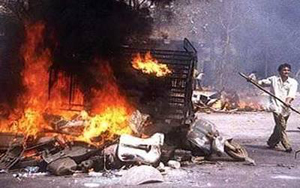Communal violence is the big bane of Indian society. While on one hand the innocents are killed the guilty mostly get away without any punishment. The rate of prosecution of riot cases is very low. Even where punishments are meted out the big fish are let off while the foot soldiers get punished. Apart from these observations what is popularized and what has become part of the ‘social common sense’ is that ‘it is Muslims who begin the riot and then they get killed’.

This episode is presented as a spontaneous anger in response to the Godhra train burning and the prosecution theory is that the mob became aggressive after Jafri fired on the mob. The question arises as to why the mob was mobilized in the first place. Can the people surrounded by such a mob feel calm? In response to Court accepting that carnage took place due to Jafri’s firing; Jafri’s son Tanveer says that this judgment is an insult to the life and work of his father, “What were the 24 police officers present doing for four hours, watching the show? The Judgment not only appears to have ignored the violent build up but appears to have been standing some of the evidence on its head. “
In the analysis of communal violence the general observation is that the narrative of events is so constructed as to blame the victim. The ‘victim as the culprit’ is the pattern of propaganda. The pretext of violence is well constructed by communal forces. To begin with the whole violence was orchestrated on the pretext of Godhra train burning, the reasons of which itself is a matter of debate. The very theory which was popularized that train was burned from outside by the Muslims holds no water as trains cannot be burned from outside and same came to be proved in this case also. By the time the truth comes out the people are made to believe through various mechanisms about the assault to the minority and then mobilized for the violence. In one of the best studies on mechanism of communal violence, V.N. Rai, ex DGP of police UP, points out “In order to guard them against external criticism and to preserve their self righteousness, violence is projected to be started by Muslims. It is as if a weaker person is pushed into the corner by a stronger, forcing him to raise his hand so that he may be suitably punished for his `attack'. Before the punishment is meted out a suitable hue and cry can be made about the fact that because the person cornered is naturally wicked and violent, he is bound to attack first" (Combating Communal Conflicts Pg. 56-57).
The court also rejects the conspiracy theory and accepts that this was a spontaneous act by the angry crowd. How does one explain the well recorded calls from Ehsan Jafri to the police and Chief Minister for help? How does one explain the police did not respond to the call for protection when it was desperately sought by Ehsan Jafri? How does one explain the police and administration’s inaction, when a possibility of police force coming and protecting the people did exist except through conspiracy theory? Those responsible for protecting the life of residents lapsed in their duty, starting from the then Chief Minstar Narendra Modi, home minister Amit Shah and other officials and have been totally let off.
In a parallel case of Naroda Patiya, the presiding judge upheld the conspiracy theory and punishment of life term was handed down to two major leaders of BJP and associates, Mayaben Kodnani and Babu Bajrangi. Yagnik points out “This was a pre-planned conspiracy and it cannot be mitigated just by saying it was a reaction to [the] Godhra train burning incident.” (The Wire, 2016) After delivering this judgment the learned judge has been getting threats of different types. The question is how conspiracy theory can be rejected in Gulbarg when the dynamics of both the cases; Gulbarg and Naroda Patiya, has been similar.
The judgment brings to our notice, many other aspects of the state of justice delivery system in general and that related to communal violence in particular. The state has been lapsing in such matters as for as prevention, controlling and giving the justice is concerned. This has led to a situation where one finds that the rate of convictions in cases of violence is poor as observed in massive cases of violence like e.g. anti Sikh (1984) post Babri Demolition (1992). Lately in Gujarat it has slightly improved. The factor in this direction has been due to the role Human rights Commission, many judges and the dogged work of civil society groups, particularly that of Teesta Setalvad, who have pursued these cases relentlessly leading to the situation where part justice is coming in. Many elements claim that this reflects the fairness of things in Gujarat. On the contrary this justice has been procured despite the heavy social and institutional biases’ prevalent in Gujarat, biases against the religious minorities.
Zakia Jafri, the widow of the slain Ahsan Jafri’s, determination to get justice for the violence victims is remarkable again. It is in the same Gulberg society that Rupa Mody lost her son and she is relentlessly pursued her struggle to locate him. Based on this tragic episode the film Parzania captures the human tragedy which visited this residential area.
One does hope that higher courts, where the matter is being taken, will give full justice to the victims of violence.




Comments
Add new comment